Cynefin
|
Field of application |
Cynefin is used for decision-making in different system realities.
|
|
Resume / Brief description
|
Cynefin is considered a sense-making framework, which means that its value is not so much in logical arguments or empirical verifications as in its effect on the sensemaking and decision-making capabilities of those who use it. The Cynefin framework is used to understand and take action in different types of systems confronting decision makers. It is often used for strategic decisions and the reflections on how to intervene in complex systems or complex contexts. It differentiates leadership roles between areas where we can concretely find out what to do (the ordered reality) and where we do not know what to do (disordered reality). Accordingly, the framework defines 4 domains and leadership requirements to intervene in a system: Clear context (the domain of best practice): We see the situation and it is very clear what has to been done. Interventions can be used that are based on best practice and existing knowledge. This is also called the realm of “known knowns”. The job of the leader is to make sense (possibly with colleagues, employees, and partners), categorise and decide what has to be done, and assure that proper processes for the intervention are in place. Then, tasks can be delegated, and intensive communication is less necessary. The motto here is: "Let us just implement it now!"
Complicated contexts (the domain of experts): More expertise and knowledge is needed in a certain situation to make a decision or to promote an intervention. The problem can be understood and solved with more deeper insights (“known unknowns”). The leader´s role with his or her teams or partners is to deepen the analysis, to identify experts with different solutions and to decide for a solution (or intervention). Planning steps and monitoring have to be assured. The motto is: "Let´s get the experts do their work according to plan, do follow up and assure that the issue is solved!”
Complex contexts (the domain of emergence): In most human and relationship-based systems we are dealing with complex contexts, in which cause and effect are impossible to trace back (“unknown unknowns”). A linear leadership style and expertise do not help in such a situation. Multiple causes and effects influence each other and it is important to provide space for experimentation and exploration. Small interventions or safe to fail experiments can help to identify patterns of responses. The patterns identified then provide ideas for further careful steps of action. The role of leadership here is to follow the logic of probe-sense-respond with other stakeholders. An environment has to be created that allows experiments and patterns to emerge. Identifying patterns and reflecting on experiment results require strong interaction and communication skills. The motto here is: “Let us experiment, open up discussions with dissent and variety, identify patterns and jointly design a variety of experiments to better judge the playing field and opportunities for further interventions!”
Chaotic contexts (the domain of rapid response): In these contexts, the situation is that unstable that cause and effect as well as patterns are totally out of any predictability and shifting constantly ("unknowable knowns"). Dave Snowden, the author of Cynefin, mentions here. “In the chaotic domain, a leader’s immediate job is not to discover patterns but to stanch the bleeding. A leader must first act to establish order, then sense where stability is present and from where it is absent, and then respond by working to transform the situation from chaos to complexity. Here hierarchical leadership styles come into play, which are not helpful in the other domains but are necessary here. The motto is: “Let's stop the crisis, reestablish order, decide top-down!” (Snowden & Boone, 2007, p.65f.)
The cliff between the simple and the chaotic domain: The Cynefin model draws a cliff between the two domains (see visualisation). While there are soft or so-called liminal areas between the domains, this liminal domain does not exist between the simple and the chaotic domain. Here you find a cliff. This means that if you mistakenly treated a system or intervention as simple or clear, but it would actually require complex or complicated patterns of action, the system can fall over the cliff and spontaneously lead to chaotic reactions. This cliff emphasises the importance and risk at the same time to not come up with simplistic answers to more complex problems.
Considering these different system realities, decision-makers have to be able to make use of different management and leadership strategies to overcome one-size-fits-all behaviour models in complex realities or, according to Snowden & Boone (2007), engage in “contextual decision-making”. |
|
Target group
|
|
|
Objectives |
The objective is to
|
|
Requirements
|
Material
Time
|
|
Implementation - Overview |
The activity is realised in 3 phases. |
|
Implementation - Guidelines
|
1. Reflection on topics that require decisions
1.1. Reflection with a team on key decision topics
The starting point of a Cynefin workshop is the question of the topic or theme that the workshop should focus on. It can be rather open or more focused. It can focus on key decision topics that have to be made (e.g. decisions to make in regard to the organisation) or are related to one theme or issue of concern (e.g. How to develop a new product? How to increase income? How to tackle the support of businesses in our region?). The focus of the workshop has to be defined in advance.
Everybody in the team writes their key inputs on relevant aspects that have to be considered (topics, answers, ideas for solutions, suggested steps forward) on each card. Everybody can write several cards so that a critical number of cards are written.
1.2. Differentiating and structuring the cards along the ordered, unordered and confused domain
The facilitator draws the horizontal line of the Cynefin framework with its three areas on the pin board: on the right the “ordered side” and on the left the unordered side, and in the middle the domain “confused”. He or she also has designed the same line on a flipchart for the table.
The facilitator puts the flipchart table with the line on the table and gives the following instruction: “Please order your cards now on the flipchart line where you think solutions can either be identified relatively easily or identified with some more expertise (under the ordered area), where you think we need more experimentation and exchange or clear decisions from the top (on the right side under unordered) or where I am not sure yet what is needed (under confused).
2. Application of Cynefin
2.1. Explanation of the Cynefin framework
The facilitator adds the horizontal line into the framework and explains all four domains (clear, complicated, complex, chaotic, and the cliff) on a pin board.
2.2. Cynefin energiser for better understanding (optional)
There is the option to make use of an energiser to better grap the idea of the Cynefin logic. Once the Cynefin has been explained the energiser can be integrated:
2.3. Organising cards along the domains
2.4. Final reflection on cards and adding new cards if necessary
3. Reflection on initiatives
3.1. What can be done for each topic/card?
3.2. Select main steps forward
3.3. Documentation of results
A Cynefin workshop is work in progress. It might be that only a few issues can be taken up. It might also be that some initiatives that were interpreted as e.g. complicated finally turn out to be complex. The pin board provides the opportunity to reorganise the cards. In that way, the first Cynefin workshop results can become a continuous process tool which helps to make sense about the process. In that respect, visualising it on a pin board or digital mural board helps to come back to it. |
|
Example of application: |
Cynefin workshop in a development project
Description of the context
The development project is focusing on the economic development of a region in an East European country. The consultancy company Mesopartner did a workshop with the team to reflect about different kinds of initiatives that can be promoted to improve the competitiveness and sustainable development of especially the regions and certain value chains like agri-processing and IT in the region.
Starting with a reflection on topics and issues and structuring them along the three horizontal domains (see phase 1)
Explanation of the Cynefin framework (see phase 2.1.)
Before introducing the Cynefin framework the cards are turned upside down so that they can be revealed and explained one by one when explaining the framework.
Organisation of cards along the domains on the Cynefin pin board (phase 2.3.)
Reflections on concrete initiatives that can be promoted (phase 3)
Findings and outcomes
The workshop revealed many insights, some of which are listed in the following:
|
|
Templates, Graphics for download |
The Cynefin Company is the author of the framework and provides much information on the Cynefin model. |
|
Additional format/references
|
Reading
Snowden, D. J., & Boone, M. E. (2007): A Leader´s Framework for Decision Making, Harvard Business Review. https://hbr.org/2007/11/a-leaders-framework-for-decision-making
Videos
Dave J. Snowden and Mary E. Boone introduce the Cynefin model: https://www.youtube.com/watch?v=N7oz366X0-8
Podcast with Dave J. Snowden: https://systemicinsight.libsyn.com/an-interview-with-dave-snowden
|

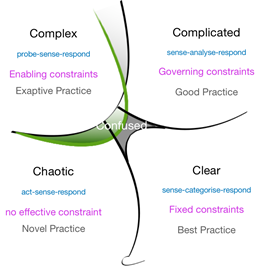
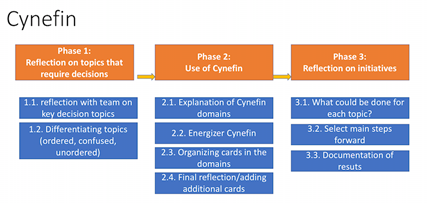

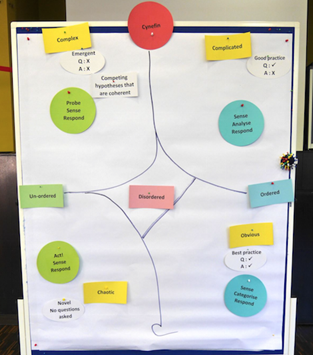
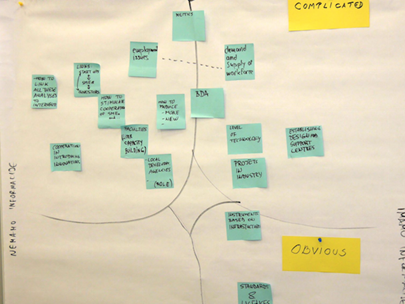
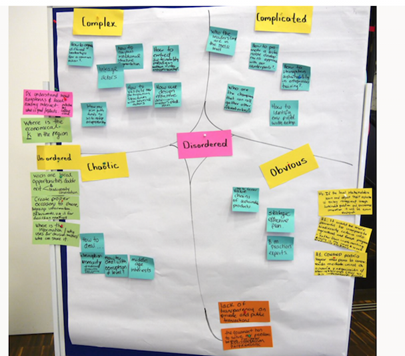
No Comments